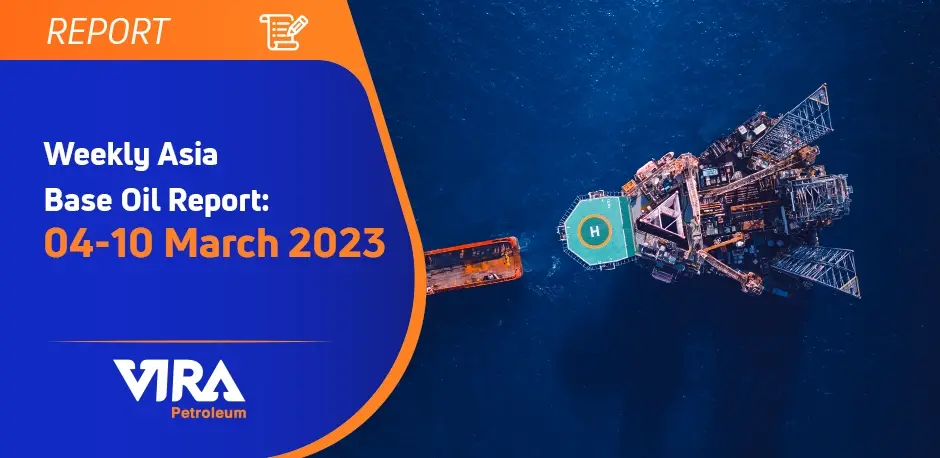A flurry of base oil cargoes was negotiated for transport from Northeast Asia to Southeast Asia and India over the week, signaling a somewhat revived regional demand. Buyers in other nations were advised to secure products before they became more scarce because activity in China and India was also beginning to build up.
Only the values for the API Group II base oils changed week to week due to tighter supply, but the energizing trade speed supported current prices. The price stability also allayed investors’ worries about buying base stocks now only to discover that prices had dropped later. Because of this, more buyers have entered the market during the past two weeks, albeit some have continued to act cautiously.
Base Oil Trends In China
The whole reversal of the strict COVID laws, as well as the rise in population mobility, overseas travel, services, and manufacturing rates, have all contributed to China’s rising lubricant consumption. Due to base oil factories’ preference for lighter grades, these circumstances have increased demand for base oils, especially the heavier grades, which are frequently in short supply in China. There are still some segments that exhibit shortfalls, and importers strive to cover those gaps by bringing in regional supplies, even if demand has been more and more fulfilled through local base stock output.
The fact that some domestic Chinese plants were planning to begin turnarounds in the coming weeks has also driven importers to hunt for merchandise overseas.
A few South Korean shipments were being discussed, including one that was scheduled to travel from Onsan, South Korea, to Nantong in the middle of March and weigh 1,000 metric tons. In the second half of March, lifting a 1,700-ton package from Onsan to Jingjiang was planned.
Base Oil Trends In Southeast Asia
Also actively offering cargo to Southeast Asian buyers are a number of vendors. The need for passenger car motor oil has surged in Thailand, Indonesia, and Japan, and domestic production was deemed insufficient to meet needs.
A number of shipping queries involving South Korean goods were noted, including one for the shipment of a 1,200-ton cargo from Ulsan to Koh Sichang, Thailand, in early April. A second similar cargo was also considered for lifting in mid-April. Around the middle of April, a 9,400-ton lot was planned to be transported from Ulsan and Daesan in South Korea to Singapore and/or Port Klang in Malaysia and Merak in Indonesia. Towards the end of March, a 1,500-ton package was scheduled to be shipped from Yeosu to Haiphong, Vietnam.
The availability of most grades has decreased, although some cuts, including the Group III 6 centiStoke and 8 cSt, were regarded to be more common than others. Also, the demand for these grades has decreased in nations like the US, which generally imports substantial quantities of Group III grades from Asia. The demand for Asian cargo may have weakened due to the lengthening of supplies in that nation, prompting suppliers to explore for alternate markets.
Base Oil Trends In India
Although lubricant consumption was anticipated to soar due to rising manufacturing output and demand from the automotive and motorbike sectors, there has been a surge in buying interest in base oils in India. These market forecasts were bolstered by upbeat data showing the Indian economy has grown significantly so far in 2023.
Customers kept relying primarily on homegrown production, and suppliers reportedly raised costs. However, despite the fact that a domestic supplier was anticipated to resume production at its Group I and Group II facilities this week after a month-long turnaround, there has also been a strong market for imports as local supply was not thought to be sufficient to meet all requirements.
Around the beginning of April, it was anticipated that Singapore will send 7,000 tons of base oils and other chemicals to Chennai, Ennore, and Kolkata. It was also discussed to send a 1,500-ton package from Ulsan to Mumbai and the Jawaharlal Nehru Port Trust around the end of March or the beginning of April. In late March, it was anticipated that some 15,000 tons will be transported from Daesan and Pyongtaek, South Korea, to the West Coast of India. At the end of March or the beginning of April, 3,200 tons were also planned to be transported from Ulsan to Mumbai and JNPT. Also being discussed was a 5,000-ton shipment to transport Daesan and Yeosu to Chennai in the second half of March.
Base Oil export price In Asia
Base oil prices in Asia were stable due to a tightening supply and demand ratio, with only a few ranges slightly increasing on rising purchasing and selling thoughts. The price ranges shown below are based on negotiations, offers, and bids, as well as deals and published prices that are commonly considered as regional benchmarks.
Singapore ex-tank prices remained largely constant from the prior week.
The spot price range for the Group I Solvent Neutral 150 grade was $920-950/t, and the price range for the SN500 was $1,030-1,070/t. All ex-tank Singapore, Bright Stock was holding at $1,290/t-$1,330/t.
Pricing for the 500N was maintained at $1,020/t-$1,070/t, ex-tank Singapore, while those for the Group II 150 neutral stayed unchanged at $970/t-$1,010/t.
The Group I SN150 was stable at $790–830/t on a FOB Asia basis, and the base oil SN500 was at $840–880/t. Prices for bright stocks held steady at $1,070/t-1,110/t, FOB Asia.
The 500N and 600N cuts both increased by $20/t to $880/t-$910/t, FOB Asia, while the Group II 150N barely increased to $860/t-$900/t.
Prices in the Group III segment remained constant. The 4 cSt was valued between $1,520 and $1,560/t, whereas the 6 cSt remained constant between $1,490 and $1,530/t. For a completely certified product, the 8 cSt grade was holding at $1,210-1,250/t, FOB Asia.
After a two-day slump brought on by concerns over the potential effects of increasing interest rates on the economy, crude oil futures turned around on Thursday. Fuel supply interruptions in France brought about by a strike over pension reforms, a decline in U.S. crude inventories, and a lower euro all reversed the declining trend.
On the London-based ICE Futures Europe exchange, Brent May futures were trading at $83.50 per barrel on March 9, down from $84.61 per barrel on March 2.
On March 8, the CME’s Dubai front-month crude oil (Platts) financial futures for April finished at $80.42 per barrel, down from $81.23 per barrel on March 1.
| SN 150 | SN 500 | Base Stocks | N 150 | N 500 | |
|---|---|---|---|---|---|
| Singapore | $920/t-$950/t | $1,030/t-$1,070/t | $1,290/t-$1,330/t | $970/t-$1,010/t | $1,020/t-$1,070/t |
| FOB Asia | $790/t-$830/t | $840–880/t | $1,070/t-1,110/t | $860/t-$900/t | $880/t-$910/t |
source:

